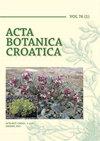极低频电磁场对有毒蓝藻raciborski圆筒精子生长的抑制作用
IF 0.7
4区 生物学
Q3 PLANT SCIENCES
引用次数: 2
摘要
本研究研究了极低频电磁场(ELF-EMFs)对有毒蓝细菌Cylindrosperopsis raciborskii(Woloszynska)Seenayya et Subba Raju的生长和抗氧化防御酶的影响。为了确定C.raciborskii生长抑制的共振频率,将细胞置于频率范围(0.1、0.3、0.5、0.7、0.9 Hz)的ELF方振幅调制波(QAMW)下,单次强度为100 V m–1,持续30分钟。结果表明,与对照培养物相比,在0.7Hz QAMW下暴露30分钟后,Cylindrosperopsis的生长抑制率最高。ELF EMF暴露培养物的细胞数量、叶绿素a含量和抗氧化酶活性显著降低,并且这种影响随着暴露时间的延长而增加。此外,ELF-EMF在暴露于0.7Hz QAMW 120分钟后诱导了Cylindrosperopsis细胞的形态学变化,包括细胞质内容物的收缩和分解,以及细胞壁的增厚。对于处理过的细胞,还观察到介电性质的变化,作为细胞成分(如质膜、细胞壁和细胞质)与电磁场相互作用的量度。我们的研究结果为使用ELF-EMFs消除饮用和娱乐水源中的有毒蓝藻提供了一种新的可能性。本文章由计算机程序翻译,如有差异,请以英文原文为准。
Growth inhibition of the toxic cyanobacterium Cylindrospermopsis raciborskii by extremely low-frequency electromagnetic fields
This study investigates the effects of extremely low-frequency electromagnetic fields (ELF-EMFs) on the growth and antioxidant defence enzymes of the toxic cyanobacterium Cylindrospermopsis raciborskii (Woloszynska) Seenayya et Subba Raju. To determine resonance frequency of growth inhibition of C. raciborskii, cells were subjected to ELF square amplitude modulated waves (QAMW) with a range of frequencies (0.1, 0.3, 0.5, 0.7, 0.9 Hz) at single intensity of 100 V m–1 for 30 minutes. The results revealed that the highest growth inhibition of Cylindrospermopsis occurred upon exposure to 0.7 Hz QAMW for 30 min. ELF-EMF-exposed cultures exhibited a marked decrease in cell number, chlorophyll-a content and activity of antioxidant enzymes compared to control cultures, and this effect increased with the prolongation of exposure time. Moreover, ELF-EMF induced morphological changes in Cylindrospermopsis cells upon exposure to 0.7 Hz QAMW for 120 min, including shrinking and disintegration of cytoplasmic contents, and thickening of the cell wall. Changes in dielectric properties, as a measure of interaction of cellular constituents (e.g., plasma membrane, cell wall and cytoplasm), with electromagnetic fields were also observed
for treated cells. Our results provide a new possibility for using ELF-EMFs to eliminate toxic cyanobacteria from drinking and recreational
water sources.
求助全文
通过发布文献求助,成功后即可免费获取论文全文。
去求助
来源期刊

Acta Botanica Croatica
PLANT SCIENCES-
CiteScore
2.50
自引率
0.00%
发文量
34
审稿时长
>12 weeks
期刊介绍:
The interest of the journal is field (terrestrial and aquatic) and experimental botany (including microorganisms, plant viruses, bacteria, unicellular algae), from subcellular level to ecosystems. The attention of the Journal is aimed to the research of karstic areas of the southern Europe, karstic waters and the Adriatic Sea (Mediterranean).
 求助内容:
求助内容: 应助结果提醒方式:
应助结果提醒方式:


